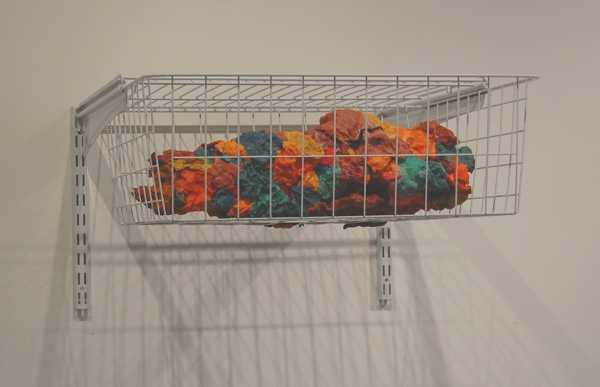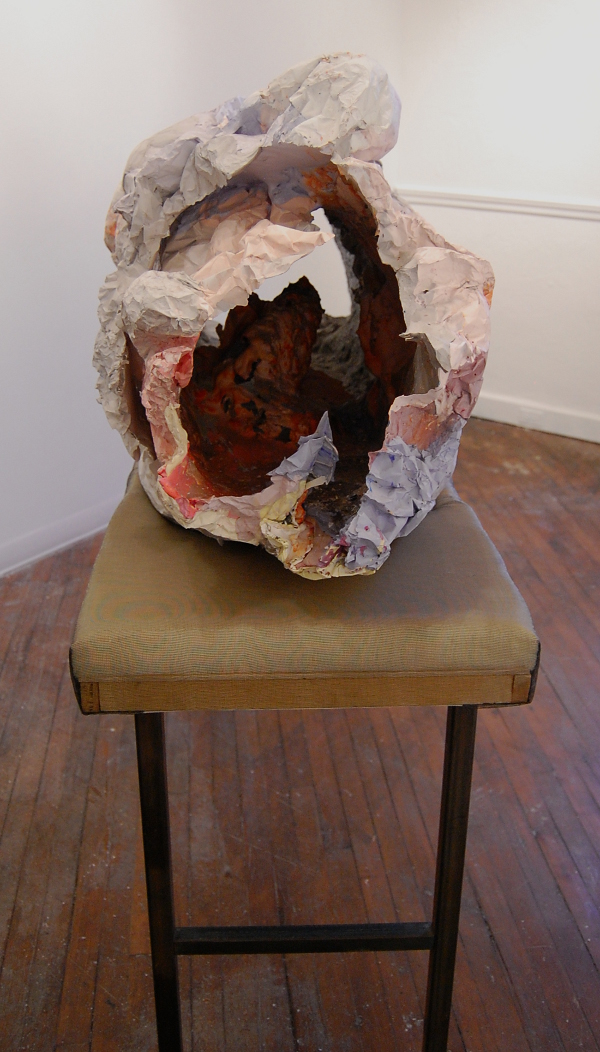
Maggie Casey and art that all but makes itself at Napoleon
Hungry? Considering walking to the refrigerator for a midnight bite? Maggie Casey may have different plans for your snacking routine, but mostly for your art-viewing routine. At Napoleon, the sculpture and installation artist explores form and happenstance via an improvisational process that allows her objects to all but make themselves. By exploring the hazy territory between intention and circumstance, Casey merely lends a hand in arranging items that largely arise on their own accord. Maggie Casey, “Breadbox.”
On one wall, we find a white basket of the plastic-coated, metal frame variety jutting out into the room. Likely lifted from some type of food storage station – a pantry, freezer, or refrigerator – it seems aerated and sturdy enough to contain numerous frozen dinners, resealable plastic bags, or fresh fruits and vegetables. Instead, there is a globular, multicolored wad of what appears almost like discarded chewing gum within. Certainly, the food choices here are less than appealing, but what is actually going on beneath the surface appearance?
Although the blob in “Breadbasket” looks revolting, it’s actually not too far from what its title implies, consisting of colored pancake batter. It looks like Play-Doh or chewing gum simply by association and because of its thrown together, unplanned configuration. Having these pieces look appetizing is hardly the point, but then again, making them look unpleasant isn’t the motive either.
Maggie Casey, “Breaker.”
When Casey sets out to make something, she allows herself a loose set of criteria, and nothing more. For the show’s title piece “Breaker,” Casey sets out to fill shoddy foil molds with plaster and then assembles a cavern-like chrysalis as she goes. Lying atop some type of massage bed, the hunk of assembled matter almost takes on the appearance of something corporeal, or at least the cavity where a body once was.
The artist seems to think the pale, curling arc of the material is reminiscent of the foamy crest of a wave as it breaks against the shore, which is, of course, how the show and artwork got their name. When it comes down to it, though, Casey has only slightly more control over the forms than the viewer does as the one who fills the molds and colors the substances, and her interpretations are therefore nearly as associative as that of her audience; she did not set out to abstract a wave, the wave emerged from her experiments with the ingredients.
Maggie Casey, “Untitled.”
Casey’s third and final piece diverges significantly from the other two as a dangling drape of plastic bags, netting and ropes. In line with Robert Morris and his floppy felt works or even Claes Oldenberg’s ‘soft’ sculptures, the artist here utilizes gravity and malleability as the hooks for her process, as opposed to solidifying liquids or mashed up foodstuffs. The mostly transparent tarp or trash bag allows for a fuzzy view of the interior materials, distorting their shapes, but refracting the colors in such a way that the piece almost glows. Hanging below the mass, we see the fibers for what they really are, and above, what they optically can be.
By harnessing materials for what they are instead of what she could will them to be, Maggie Casey raises a multitude of questions about the art making process. How much is contemporary art dependent on decision-making on the part of the artist? To what degree can materials themselves constitute a work of art? Regardless, these are discussions worth having, and Maggie Casey is not one to shy away from asking the right questions.
Napoleon is located at 319 North 11th St., on the second floor, Philadelphia; [email protected]; napoleonnapoleon.com.
Recent Content
-
Artsarticle ·
-
Artsarticle ·
-
Artsarticle ·



